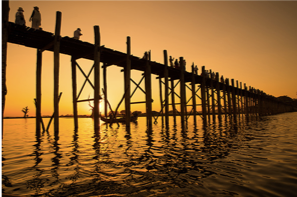
The Shwedagon Pagoda and also known as the Great Dagon Pagoda and the Golden Pagoda
is a
gilded stupa located in Yangon, Myanmar.
The Shwedagon is the most sacred Buddhist pagoda in Myanmar, as it is believed to
contain relics of the four previous Buddhas of the present kalpa. These relics
include
the staff of Kakusandha, the water filter of Koṇāgamana, a piece of the robe of
Kassapa,
and eight strands of hair from the head of Gautama.
Built on the 51-metre (167 ft) high Singuttara Hill, the 112 m (367 ft) tall pagoda
stands 170 m (560 ft) above sea level,[note 1] and dominates the Yangon skyline.
Yangon's zoning regulations, which cap the maximum height of buildings to 127 metres
(417 feet) above sea level (75% of the pagoda's sea level height), ensure the
Shwedagon's prominence in the city's skyline.




| Capital | Nay Pyi Taw |
|---|---|
| Largest City | Yangon |
| Area | 676,578㎢ |
| Population | 54,409,794 people (April 2020) |
| Religion | Approximately 90% of all Buddhist countries (Theravada Buddhism). Approximately 6.3% are Christians and 2.3% are Muslims. |
| People | There are eight major tribes and a total of 135 ethnic groups. Eight major tribes: Burmese, Shan, Karen, Rakhine, Hmong, Kachin, Kayah, and Chin. |
| Currency | MMK (Kyat) |
| Time difference with Japan | -2 hours 30 minutes |



Myanmar not only offers natural resources and arable land in abundance – importantly, the
country also possesses a skilled, motivated and young population. In the previous years of
political and economic reform, Myanmar society has shown to be capable of driving change.
Myanmar’s citizens have demonstrated flexibility in adapting to the availability of new
opportunities and in dealing with new technology (the ‘digital leapfrogging of Myanmar’),
while acquiring new skills and competencies in a learning society – as employees and
entrepreneurs. Particularly in Yangon, and increasingly in urban centres in all of Myanmar,
traditional life and modernity mix harmoniously – society is open, warm and welcoming to
foreign cultures and influence.
Myanmar is the largest country in mainland Southeast Asia and has – beyond its domestic
market of more than 50 million citizens – direct access to China, India, ASEAN and other
international markets through ports along the Bay of Bengal and Andaman Sea.
After decades of international isolation prevented the modernisation and expansion of
infrastructural networks, the Myanmar government is prioritising the establishment of
efficient national and international supply chains for future economic growth – particularly
in terms of power infrastructure, road, rail, air and ports.







